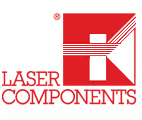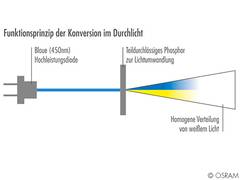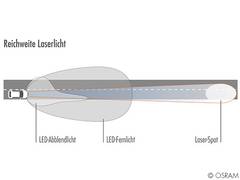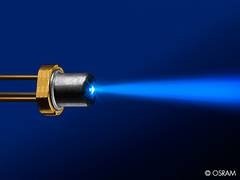OSRAM Develops Laser Diodes for Automotive Lighting
Blue laser light is already being used on the road
D77-243
Ralf Hying, OSRAM.
Car fans are fascinated and designers love the new creative possibilities. For lighting technicians, laser light represents a welcome new source of light. But what is behind this technology?
Two misconceptions are widespread in connection with laser light. The first is that the purpose of a laser beam is to illuminate the road. And second, this fuels the fear that highly concentrated light is dangerous. However, this is incorrect and the fear unfounded. Although a blue laser is involved, a laser beam does not leave the headlight.
Laser Light – How Does it Work?
The operating principle of automotive lighting is different. Inside the headlight, the laser beam hits a phosphor and excites it to light up – resulting in a so-called “conversion” of the laser light. This principle is comparable to the conversion of a classic fluorescent lamp or a white LED. In a fluorescent lamp, UV light is converted into visible light; in the LED, blue light is converted. Fluorescent materials are also referred to as “phosphors”. The pure element phosphorus is not involved; rather, the fluorescent materials used are high-performance ceramic materials which may contain phosphorus compounds. Together with a carrier material, the fluorescent materials are processed into partially transparent sheets. In addition to geometry, the material selection, processing, and optical characteristics of the converter unit are decisive for the performance and, therefore, the subject of development.
The second misconception of laser light concerns the amount of light. The development was not set in motion because existing light sources do not produce enough luminous flux but to utilize light sources of unprecedented luminance. Developers are able to pick from a sufficient number of other conventional light sources that generate very high luminous flux. For more than 20 years, for example, gas discharge technology (in the form of xenon headlights in cars) has been used.
Lots of Light from Tiny Headlights
The advantage of laser light is that it allows you to produce a lot of light that is exactly guided from very compact headlights. An example may illustrate this concept: A common halogen high-beam headlight with a light intensity of about 100,000 candelas (cd) has a diameter of ca. 220 millimeters. For a comparable amount of light, laser technology requires only 30 millimeters.
Hybrid Lighting Concepts
The first vehicles with laser light are already being used on the road. Car manufacturers rely on hybrid lighting concepts: LEDs are used for the main lighting function; an additional high beam (which only switches on at higher speeds) can be implemented using laser light technology.
This new technology is expected to be implemented in the future in a similar way; that is, in combination with established light sources. Each lighting concept will be able to contribute its particular features, and a wide variety of combinations is conceivable. In addition to LEDs, xenon, and lasers in the headlights, OLEDs will be implemented in taillights in the future.
Car manufacturers will use lasers, LEDs, and OLEDs particularly for design purposes but also to emphasize their technical aspirations and their innovative spirit. From a lighting perspective, laser light sources provide a significantly higher luminance than all light sources previously established in the automobile. For this reason, laser light may be regarded as the specialist for high-beam functions. Furthermore, it can become the illumination of choice wherever high light output is desired from very small footprints, as well as light exit surfaces that are just as small. However, the engineers at Osram think even further. They already envision application scenarios inside the vehicle, for example laser projectors that replace existing displays.
Design Advantages of Fiber Optics
Another advantage of laser light is that the actual light source (i.e., the laser diodes) does not necessarily have to be located inside the headlight. Connected to an optical fiber, they can be placed pretty much anywhere inside the car. This makes the technology particularly interesting especially if there is only very little installation space available inside the engine compartment.
Innovative Light Technology from Decades of Expertise
In 2006, Osram began to develop suitable laser diodes. The first prototypes were based on indium-gallium-nitride compounds. When the subject of laser light became a topic for the automotive industry, Osram merged two previously separate technologies: the laser and the converter. The latter refers to the initially described fluorescent material which turns the laser into useful light. Osram possesses many years of experience in both areas. For almost 40 years, Osram Opto Semiconductors has developed and produced both LEDs and semiconductor lasers. At the Regensburg production facility, InGaN-based LEDs have been manufactured since 1996. The knowledge gained from blue LEDs has significantly benefited the development of the blue laser.
One special challenge was the increase in efficiency of blue light. For physical reasons, laser diodes for red and infrared wavelengths convert the input energy better than what is possible at the other end of the light spectrum – the blue region. Therefore, blue laser diodes produce more waste heat that must be dissipated by appropriate cooling measures. In 2013, Osram was able to increase the efficiency for blue laser diodes in the watt-output range to 30 percent and thus reduce the need for cooling.
A Challenging Environment: The Automotive Industry
A lot of effort was required to adapt the laser diodes to the automotive environment. The requirements of operation and car manufacturers are high. For example, headlights (and thus the laser diodes) have to work in a temperature range from -40 to +80 degrees. Likewise, high humidity must not pose a problem. The tests, in which both laser diodes and entire light modules must prove their resistance to strong vibrations, are also very complicated. Such stress is unknown in consumer electronics where a much lower temperature range is common. This difference is evident, for example, when a smartphone attached to the windshield stops operating in hot weather and sunshine while the car electronics naturally continue to work.
In fulfilling these requirements, Osram has benefited from the experience gathered as world leader in the automotive sector for other lighting products, such as xenon or semiconductor-based technologies. This includes laser diodes for application in distance measurement in driver assistance systems. However, these lasers have much less power and operate in the infrared spectrum. A diode possessing the laser class required for laser light had never before been employed in a car and under such – relatively extreme – environmental conditions.
In addition to the technological challenges, obstacles for series production of laser light include safety and approval matters. Several security systems are installed to ensure that during normal operation, laser light is not able to exit the headlight and cause damage, for example, to the human eye. The systems are designed so that after the headlight has been damaged (e.g., after an accident) the laser is switched off immediately.
Hardly any part of the car is as heavily regulated as the lights. The characteristics of the headlight must meet existing ECE regulations. Thus, a maximum level of 200,000 candelas applies for high beams. Therefore, higher glare values than other headlights need not be feared. Laser light is supposed to increase security and not endanger other road users.
Ralf Hying has a graduate degree in electrical engineering and has worked at Osram since 2005. As program manager, he has been responsible for the entire field of laser applications since 2011.
Datasheet:
Further product information:
Manufacturer:
OSRAM Opto Semiconductors
Contact:
| Contact Person: | Winfried Reeb |
| Company: | Laser Components Germany GmbH |
| Address: | Werner-von-Siemens-Str. 15 |
| ZIP / City: | 82140 Olching |
| Phone: | +49 (0) 8142 2864-42 |
| Fax: | +49 (0) 8142 2864-11 |
| Email: | winfried.reeb@lasercomponents.com |
| |
|























































